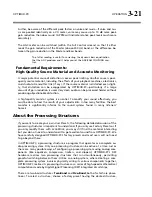
3-22
OPERATION
ORBAN MODEL 1101
and, if you wish, edit it to create a user preset. To put a given structure on the air,
recall a factory or user preset associated with that structure.
Five-Band:
The Five-Band structure is very flexible, enabling you to fine-tune your
sound. There are several basic Factory Presets for the Five-Band structure. Each of
these presets can be edited with the L
ESS
-M
ORE
control.
This control affects the video-oriented presets differently than it does the music pre-
sets. When a video-oriented preset is on the air, the L
ESS
-M
ORE
control adjusts the
average amount of gain reduction by adjusting the drive level to the Five-Band
structure's input. This also adjusts the
idle gain—
the amount of gain reduction in
the AGC section when the structure is gated. (It gates whenever the input level to
the structure is below the user-adjustable threshold of gating.)
When a music preset is on the air, the L
ESS
-M
ORE
control sets the amount of overall
processing, making optimum tradeoffs between loudness, brightness, and distor-
tion. In sound for picture, there are no loudness wars; for music presets, there is
probably never a need to advance the L
ESS
-M
ORE
control beyond 5.
The stereo enhancer, AGC, equalizer, and look-ahead limiter are common to both
Two-Band and Five-Band processing and therefore stay the same when OPTIMOD-PC
switches between two-band and five-band operation. However, different controls
appear in the screens containing dynamics processing controls, as appropriate for
Two-Band or Five-Band multiband compression. The meters also change, displaying
the Two-Band or Five-Band gain reduction as appropriate.
The Two-Band and Five-Band multiband compressors are always running. Switching
between Two-Band and Five-Band therefore occurs with via a cross-fade. Even
though no audio mute occurs, switching still can sound obtrusive if the loudness
normally produced by the two-band and five-band presets is very different. It is usu-
ally possible to eliminate audibly obtrusive switching artifacts by tweaking one (or
both) of the presets to make them sound closer to each other and saving the results
as user presets.
Two-Band:
The Two-Band structure consists of a slow two-band gated AGC (Auto-
matic Gain Control) for gain riding, followed by a gated two-band compressor and a
look-ahead limiter. By choosing the AGC crossover mode correctly, the Two-Band
Structure can be made phase-linear throughout to maximize sonic transparency.
The Two-Band structure has an open, easy-to-listen-to sound that is similar to the
source material if the source material is of good quality. However, if the spectral
balance between the bass and high frequency energy of the program material is in-
correct, the Two-Band structure (when its
B2-B1
C
OUPLE
control is operated toward
0%) can gently correct it without introducing obvious coloration.
In radio-oriented applications, the Two-Band structure is mainly useful for classical
or “fine arts” programming that demands high fidelity to the original program
source. The
PROTECTION
preset is a Two-Band preset that provides the highest fi-
delity; other Two-Band presets provide more processing.
Summary of Contents for Optimod-PC 1101
Page 4: ......
Page 14: ......
Page 121: ...OPTIMOD PC OPERATION 3 1 Section 3 Operation Figure 3 1 The OPTIMOD PC Control Application...
Page 192: ...3 72 OPERATION ORBAN MODEL 1101...
Page 204: ......
Page 210: ......
Page 212: ...5 2 UNINSTALLATION ORBAN MODEL 1101...
Page 236: ......
















































